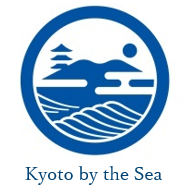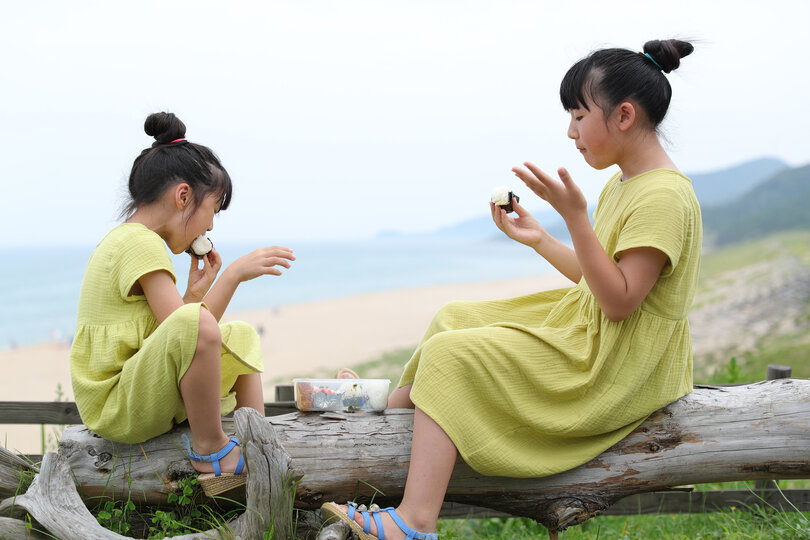Melons and peaches and pears, oh my!
trip and trail 9.1.2020
A lucky encounter with Tango-grown peaches
The top news stories on TV for the past few months have been all about the Corona Virus. Until just half a year ago, I used to want to drink beer whenever I thought about "corona." I started working from home in April and I think I have finally gotten used to the rhythm of this new life. As soon as I finish work, I make my way down to the living room, where my wife greets me and asks me to go to the supermarket. I'm happy that I have a reason to do something outside, so I happily accept the task when asked. At the supermarket, I first check the fresh food department. My wife’s clear instructions echo in my mind. I've been reminded several times not to shop only for whatever produce was the cheapest. In the fruit section, I see peaches, a favorite of my eldest daughter. "Kyotango product" is written above on the product label. I’m interested in what a peach grown in a town on the Sea of Japan would taste like, so I buy two.
The Kyotango peach I have with my family after dinner is fresh, juicy, with a deep sweetness. My wife and daughters praise me, saying “Dad, nice one.” I’m secretly happy they praised my selection. Maybe because of this positive reinforcement, I search for "Kyotango” and “peach" and find that not only peaches, but melons, pears, grapes, and even the words, “fruit garden” show up in my search. Fruits of all kinds are my wife’s and two elementary school daughters’ favorite foods, so I suggest a day trip to Kyotango to my wife. She agrees and says “It's going to be a great experience for the children.”
So it’s decided.
melon picking is a treasure hunt
On Saturday morning, my wife is preparing rice balls with our daughters because we are still a bit uneasy about eating out. During this period of social distancing our daughters have come to embrace the joy of cooking. It looks fun, the three of them together preparing food for the trip. Meanwhile, I check the route again, aiming for a 10 a.m. arrival in Kyotango. This will be our first time going out for a drive in a long time.
The first destination is "Tango Kingdom Fruit Garden." After only driving for two hours the scenery has completely changed, with the countryside landscape of rice fields and mountains spreading out before us. When I get out of the car and take a deep breath, I can smell the fresh mountain air mixing with a soft sea breeze. In this region, it’s possible to experience seasonal fruit picking from spring to early winter. As it’s summer, today’s mission is melon picking. For 1,900 yen per person, we can bring back one harvested melon. When I apply for our daughters at the reception, a kind, tanned worker guides us to the greenhouse. The melons are cultivated in multi-level raised beds set at eye level and have large green leaves. While walking through the jungle-like melon house, the leaves brush against our arms while we walk.
The melon hunting here is quite unique. The melon seedlings are numbered in the order in which they were pollinated, and because the numbers are written directly on the surface of the leaves, anyone can check them. We were given a numbers to look for before entering the greenhouse, which would be our melons if we can find them. It’s kind of exciting and it feels like we are on a treasure hunt. My youngest daughter gets the hang of it quickly, looking through the leaves for the numbers we are seeking. I’m having a lot of fun looking through the leaves for our prize as well. And the joy of finding our melons is a reward all by itself. I am instructed to leave the melon’s vine in its signature T-shape when cutting it free. I slowly insert the scissors and cut, feeling the weight of the melon as it fully drops into my left hand. And our second reward for all our hard work searching through the melon-forest, is our very own, ripe Kyotango melon.
Next we head to JA’s direct sales office, so we can send melons to my wife’s parents, who we have had a difficult time trying to see during COVID. During the summer, Kotobiki melon is a Kyotango City brand name melon and popular gift. When we arrive, the JA building is lined with melons that have already been carefully boxed and are awaiting shipment. The gold-colored "Kyoto brand" product sticker on the box is a mark that guarantees high quality. This incredible melon with its criss-crossing mesh-like husk is sold for unimaginable prices in Osaka. Since they are such a big deal, I decided to purchase an extra for a friend who recently had a baby.
After leaving the direct sales office, we drive to Kotobikihama beach for lunch. The white sand and green pine beach, which extends for about 1.8 km, is a scenic spot that has been designated as a Japanese Natural Monument. We take out our rice balls my wife and daughters made this morning, sit on the driftwood under a pleasant sea breeze, and eat together. The rice balls hit the spot after a morning of treasure hunting. Afterwards we take a short stroll along the shore. The seawater is so transparent and beautiful that we have no problem seeing down into the sand beneath the water. The beach looks so inviting that next time, I’ll bring a swimsuit.
On to the Fruit Trail
In the afternoon, we head to the “Fruits Trail” that my wife found online. This “Fruits Trail” is actually an initiative started by young farmers in 2017 to share the deliciousness of local fruit. Currently, seven farms and cafes work together in this cooperative to offer seasonal fruits and fruit-related products like desserts, juices, smoothies, and frappes. These seven locations are conveniently close to the main freeways and it’s easy to hop from one to the next, which is great for anyone with a sweet-tooth.
TAN Frappe, filled with ripe Tango-grown melon
The first stop on our fruit trail is Kumihama’s SANKAIKAN. My wife's goal is the TAN Frappe, which is packed with pulped Tango-area melon and has such a rich sweetness, I can’t stop sampling it. Our elder daughter, who likes peaches, naturally chooses a peach smoothie without hesitation. Our younger, who was interested in the pear tree farms we passed on the way here, selects a pear smoothie.
Continuing on our way, we arrive at "Ieki Farm." By car, it only took three minutes. Here, freshly harvested peaches are being sold. The sweet scent of peach floods our senses as we enter the market. "I want to eat one now!" our usually quiet older daughter exclaims. There is a huge variety of peaches and we are able to choose the ones we want and have them cleaned and ready to eat on the spot. Our girls try to fit their mouths around the fruit and bite in, peach juices overflowing onto their cheeks. “It’s so sweet.” “Its so juicy!” Our girls are so excited that their fingers are sticky with peach juice. My wife has chosen a peach parfait and tells me I will regret not trying it, so I join in the peach frenzy. The parfait is amazing, and it also contains peach-made gelatin, compote, and sorbet.
As we are savoring the sweet peaches, Mr. Ieki, the shopkeeper who helped us choose our peaches, asks, “Would you like to see the peach garden?" Both of my daughters are looking up at Mr. Ieki, eyes glittering. Located close to the market, the peach garden is filled with fruit at their peak ripeness. It’s easy to see that these peaches are grown with care before being lovingly wrapped in paper for selling. Mr. Ieki tells us that the peaches here are especially delicious thanks to the sea breeze.” We thank Mr. Ieki for his time and the stories he shared with us.
Our last fruit trail stop is Umi no Mieru Shiraiwa Tsunemi Farm. This is another excellent location to get local fruit, smoothie-style. My wife has her eye on a red-melon smoothie that goes by the name of “Cupid” on the menu. It’s made with a rare melon with a high sugar content. I also found a watermelon smoothie (which I had been hoping to find), so I ordered it. It's strange but I think the “smoothness” of smoothies makes the sweetness and flavor of the fruit stand out even more. Our daughters, who should have already eaten so much, share a grape smoothie. The grapes are as big as chestnuts. We arrive at the same time as a quartet of sightseers who have apparently rented electric-assisted bicycles (e-bikes) from Yuhigaura beach, about four kilometers away. They also came in search of Mr. Shiraiwa’s famous smoothies. “This is the perfect spot on a summer day,” they tell us.
while we watch the sun set
We end the day at Yuhigaura, where the sun sets over the Japanese Sea. The girls are swinging on an iconic driftwood swing on the beach.
"Thank you for today, Dad. Kyotango’s a wonderful place," My wife says gently, both our eyes facing the children. Looking out at the sunset, I reply, “I’m happy when everyone is happy.”
Today’s trip has been completely uplifting, and it encourages me to think about our next family outing. I heard that it’s easy to rent e-bikes in Amanohashidate and Ine, and after meeting those four riding e-bikes to the fruit stand, I think it’s something my family would really enjoy. Ine is a town I’ve wanted to visit for quite a while now, and traveling around the bay on an e-bike would be really fun.














